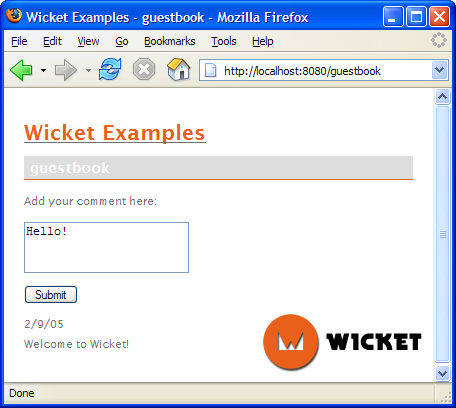Guestbook
The GuestBook application allows users to enter comments that appear on a
page like a weblog. Drawing the list of comments is very easy with the Wicket
ListView component. This example also gives an impression of what form
handling is like.

As with all examples, you have to put all files in the same package directory. This means putting the markup files and the java files next to one another. It is possible to alter this behavior, but that is beyond the scope of this example.
Comment.java
The Comment POJO model is very straightforward:
package org.apache.wicket.examples.guestbook;
import java.util.Date;
import org.apache.wicket.IClusterable;
public class Comment implements IClusterable {
private String text;
private Date date = new Date();
public Comment() {
}
public Comment(final Comment comment) {
this.text = comment.text;
this.date = comment.date;
}
public String getText() {
return text;
}
public void setText(String text) {
this.text = text;
}
public Date getDate() {
return date;
}
public void setDate(Date date) {
this.date = date;
}
public String toString() {
return "[Comment date = " + date + ", text = " + text + "]";
}
}GuestBook.java
In the file GuestBook.java we have put the Java component code for the
guestbook page. This is the homepage for the guestbook application. The page
consists of a form for entering new items to the guestbook and a list of
repeating markup for showing the guestbook entries.
The GuestBook constructor adds a CommentForm and a ListView of
the comments. Notice how the model is passed in as the second argument to the
ListView constructor.
Then as the view renders, the populateItem method is called passing in a
ListItem container for the current row in the list.
The implementation below obtains the Comment POJO from the list item and
adds label components for the date and text of the Comment. This is all
accomplished in just a few lines of code.
package org.apache.wicket.examples.guestbook;
import java.util.ArrayList;
import java.util.Collections;
import java.util.Date;
import java.util.List;
import org.apache.commons.lang.StringUtils;
import org.apache.wicket.examples.WicketExamplePage;
import org.apache.wicket.markup.html.basic.Label;
import org.apache.wicket.markup.html.basic.MultiLineLabel;
import org.apache.wicket.markup.html.form.Form;
import org.apache.wicket.markup.html.form.TextArea;
import org.apache.wicket.markup.html.form.TextField;
import org.apache.wicket.markup.html.list.ListItem;
import org.apache.wicket.markup.html.list.PropertyListView;
import org.apache.wicket.model.CompoundPropertyModel;
import org.apache.wicket.util.value.ValueMap;
public final class GuestBook extends WicketExamplePage {
/** A global list of all comments from all users across all sessions */
private static final List<Comment> commentList = Collections.synchronizedList(new ArrayList<Comment>());
/**
* Constructor that is invoked when page is invoked without a session.
*/
public GuestBook() {
// Add comment form
add(new CommentForm("commentForm"));
// Add commentListView of existing comments
add(new PropertyListView<Comment>("comments", commentList) {
@Override
public void populateItem(final ListItem<Comment> listItem) {
listItem.add(new Label("date"));
listItem.add(new MultiLineLabel("text"));
}
}).setVersioned(false);
}
/**
* A form that allows a user to add a comment.
*/
public final class CommentForm extends Form<ValueMap> {
public CommentForm(final String id) {
// Construct form with no validation listener
super(id, new CompoundPropertyModel<ValueMap>(new ValueMap()));
// this is just to make the unit test happy
setMarkupId("commentForm");
// Add text entry widget
add(new TextArea<String>("text").setType(String.class));
// Add simple automated spam prevention measure.
add(new TextField<String>("comment").setType(String.class));
}
/**
* Show the resulting valid edit
*/
@Override
public final void onSubmit() {
ValueMap values = getModelObject();
// check if the honey pot is filled
if (StringUtils.isNotBlank((String)values.get("comment"))) {
error("Caught a spammer!!!");
return;
}
// Construct a copy of the edited comment
Comment comment = new Comment();
// Set date of comment to add
comment.setDate(new Date());
comment.setText((String)values.get("text"));
commentList.add(0, comment);
// Clear out the text component
values.put("text", "");
}
}
/**
* Clears the comments.
*/
public static void clear() {
commentList.clear();
}
}When the CommentForm is submitted, the onSubmit() method is called.
Notice that nothing gets the value of the TextArea that was added in the
CommentForm constructor. This is because the comment is the model and the
third parameter to the TextArea constructor specified the property of the
model to update. So all onSubmit() has to do is create a new comment from
the model that was updated and add it to the comment list. When the page
redraws, the new list will be rendered.
We use a synchronized list as our shared static model used by commentListView
(commentList) to ensure that it is only updated by one thread at a time.
Remember, this is a multi-user application with a shared model!
Finally, you may notice the call to commentListView.modelChanged(). This
informs the list view that its model has been modified. In more advanced
usage scenarios, this would allow Wicket to expire stale pages accessed with
the browser’s back button.
GuestBook.html
In the HTML below, notice the way that the TextArea component is being
nested inside the CommentForm. Wicket is able to keep everything straight
because the Java Component.add() calls have to result in the same nesting
structure as the HTML.
Finally, notice the <wicket:remove> block. This is simply markup that is
there for previewing purposes only. When the page renders, it is stripped
out.
<html xmlns:wicket="http://wicket.apache.org/">
<head>
<title>Wicket Examples - guestbook</title>
<link rel="stylesheet" type="text/css" href="style.css"/>
</head>
<body>
<span wicket:id="mainNavigation"/>
<form wicket:id="commentForm">
Add your comment here:
<p>
<textarea wicket:id="text">This is a comment</textarea>
<input type="text" wicket:id="comment" class="nospam" onfocus="getElementById('formsubmit').focus();"/>
<p>
<input type="submit" value="Submit" id="formsubmit"/>
</form>
<p/>
<span wicket:id="comments">
<p>
<span wicket:id="date">1/1/2004</span><br>
<span wicket:id="text">Comment text goes here.</span>
</p>
</span>
<wicket:remove>
<p>
1/2/2004<br/>
More comment text here.
</p>
</wicket:remove>
</body>
</html>GuestBookApplication.java
For completeness, we’ve included the GuestBookApplication class, and as a
final treat the modifications to the web.xml file.
package org.apache.wicket.examples.guestbook;
import org.apache.wicket.Page;
import org.apache.wicket.examples.WicketExampleApplication;
public class GuestBookApplication extends WicketExampleApplication {
public GuestBookApplication() {
}
@Override
public Class< ? extends Page> getHomePage() {
return GuestBook.class;
}
}web.xml
Add the following two sections (servlet and servlet-mapping) to your web.xml file for running this application.
<filter>
<filter-name>GuestBookApplication</filter-name>
<filter-class>org.apache.wicket.protocol.http.WicketFilter</filter-class>
<init-param>
<param-name>applicationClassName</param-name>
<param-value>org.apache.wicket.examples.guestbook.GuestBookApplication</param-value>
</init-param>
</filter>